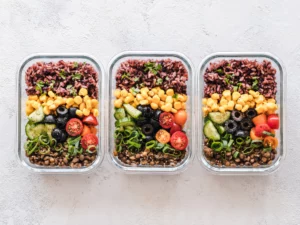Life as a busy family can feel like a whirlwind of to-do lists, packed schedules, and trying to get dinner on the table. But making sustainable choices doesn’t have to be complicated. By incorporating a few small changes into daily routines, families can significantly reduce their carbon footprint—without adding any extra stress.
Here are some simple, actionable sustainability hacks that fit perfectly into the lifestyle of busy families.
1. Eco-Friendly Meal Planning for Busy Families
Meal planning is a lifesaver for busy families, but it’s also a fantastic opportunity to make more eco-friendly choices and reduce your carbon footprint.
Start by planning meals around in-season and local produce. Fruits and vegetables that are in season require less energy to grow and transport, making them a more sustainable choice. Shopping at local farmers’ markets or subscribing to a community-supported agriculture (CSA) program supports local growers and lowers the environmental impact of transportation.
Batch cooking and meal prep are excellent strategies for saving time and reducing energy use. Cooking large portions at once saves electricity by minimizing multiple cooking sessions. You’ll also have nutritious, plant-based meals ready to go, making it easier to avoid the temptation of takeout or packaged foods.
Minimizing processed foods is another great sustainability hack. Highly processed foods often come with excessive packaging and require more energy to produce. Focusing on whole, simple ingredients not only benefits the environment but is also healthier for your family.
2. Reducing Food Waste: A Key Sustainability Hack for Families
Reducing food waste is one of the most effective ways to lower your family’s environmental impact. Did you know around 1.05 billion tons of food waste in 2022 came directly from households, restaurants, and retail? Even more alarming, while an estimated 735 million people go hungry globally, food loss and waste generate 8 to 10 percent of greenhouse gases and are a major source of methane.
Smart storage can prevent food from going bad too quickly. Using eco-friendly storage options like glass containers, reusable wraps, or silicone bags can help keep produce fresh while cutting down on plastic waste. Storing foods properly, like keeping herbs in water or separating certain fruits and vegetables, can extend their shelf life and reduce spoilage.
Repurposing leftovers is a simple way to eliminate waste. Leftover rice? Use it in a stir-fry. Extra roasted veggies? Turn them into a soup or salad. Being creative with leftovers ensures nothing goes to waste, and it can also save you time during busy weeks.
For any food scraps you can’t use, composting is a fantastic solution. Composting keeps food waste out of landfills and creates nutrient-rich soil that can be used in home gardens or for plants. Composting can be as simple as a small indoor bin or an outdoor compost pile.
My Experience with Composting
Composting is one of my favorite ways to reduce food waste, and I’ve tried a few different methods over the years. Right now, I’m using the Lomi Smart Composter, and I absolutely love it—even though it can be a little noisy. Lomi turns food waste into nutrient-rich dirt overnight, which is much faster than traditional methods. It’s so convenient for my busy family because I can compost more materials, like vegetable peels, coffee grounds, and even compostable packaging, without worrying about bad odors or mess. It fits perfectly in my kitchen, and I’m able to cut down on our garbage significantly. Sure, it makes some noise, but for how quickly it works, I’ll take it! By the time I wake up, my food waste has already transformed into usable fertilizer for our plants.
Before Lomi, I tried a stackable worm composter. Vermicomposting is a great, low-cost option, but it didn’t work as well for me in the long term. While I initially loved the idea and the compact, stackable design, I struggled to keep the worms cool since my composter was outside, and I live in a hot climate. The worms can get overwhelmed if you try to compost too much at once, and I found I couldn’t use it as often as I needed. That said, the worm castings were incredible for the garden, and you also get “worm tea” which is a fantastic liquid fertilizer. If you have the right environment, it can be a great option!
Lastly, for anyone looking to compost for free at home, it’s totally possible with just a simple outdoor pile. All you need is a spot to gather kitchen scraps like fruit and vegetable peels, coffee grounds, and yard waste like leaves and grass clippings. Turn the pile regularly, and over time, you’ll get rich compost. If you have space in your yard, this is an easy and cost-free way to recycle food waste and nourish your garden.
3. Sustainable Kitchen Products to Reduce Your Family’s Carbon Footprint
The kitchen is often the heart of the home, and making it more eco-friendly is an easy way to reduce waste and lower your carbon footprint.
Start by switching to reusable and durable kitchen products. Replace plastic bags with reusable silicone storage bags, paper towels with cloth napkins, and disposable straws with stainless steel or bamboo options. These simple swaps reduce the amount of single-use items that end up in landfills.
Energy-efficient appliances can also help reduce your family’s energy consumption. If you use the oven or stovetop frequently, consider investing in energy-efficient alternatives like a slow cooker, pressure cooker, or induction cooktop. These appliances use less electricity and are perfect for busy families who want to save time and energy.
Finally, opt for plant-based, biodegradable cleaning products for dishwashing and kitchen cleaning. They’re not only gentler on the environment but also safer for your family. You can also minimize water use by ensuring your dishwasher is full before running it.
4. Mindful Shopping for Sustainable Living
Being mindful of how you shop is another easy and effective sustainability hack for busy families, and it doesn’t have to break the bank.
Buying in bulk is a great place to start. Purchasing grains, nuts, and dry goods in bulk reduces packaging waste and often costs less in the long run. Don’t forget to bring reusable bags and containers to the store to further minimize plastic use.
When choosing products, look for those with minimal or recyclable packaging. Selecting items with glass, cardboard, or compostable packaging instead of plastic helps reduce the amount of single-use waste your family generates.
Incorporating more plant-based meals into your weekly meal plan is one of the best ways to reduce your family’s carbon footprint. Plant-based foods require fewer resources to produce than meat and dairy, making them a more sustainable choice. Plus, simple meals like veggie stir-fries, lentil soups, and hearty grain bowls are quick, family-friendly, and packed with nutrients.
5. Get the Whole Family Involved in Sustainability
Sustainability isn’t just something for parents to worry about—it’s a great opportunity to teach kids about taking care of the planet. By making sustainability fun and engaging, you can build lifelong habits together as a family.
Composting can be a fun science experiment for kids. Watching food scraps turn into soil sparks curiosity about nature, and it gives children hands-on experience with recycling organic waste. Gardening is another excellent way to get kids involved in sustainability. Whether it’s growing herbs on a windowsill or planting vegetables in the backyard, gardening helps them understand where food comes from and encourages them to appreciate it.
Setting family sustainability challenges can make eco-friendly living fun. Try challenging everyone to a “no plastic” week or a competition to see who can come up with the best leftover-based meal. These challenges turn sustainability into a family game that everyone can enjoy.
Living sustainably as a busy family doesn’t have to be overwhelming. By making small, simple changes—like eco-friendly meal planning, reducing food waste, and using sustainable kitchen products—you can reduce your carbon footprint and create positive habits for the planet. And by involving the whole family, you’ll create a home that not only cares for each other but also for the world around you.


